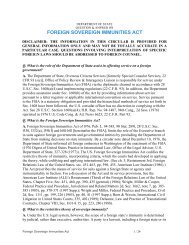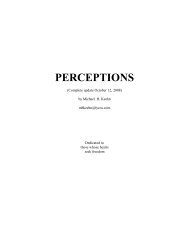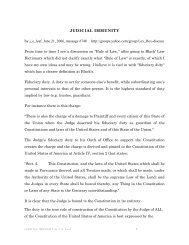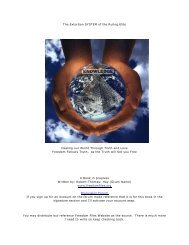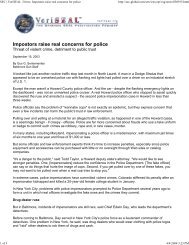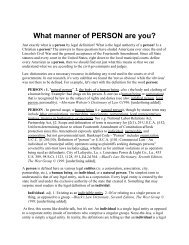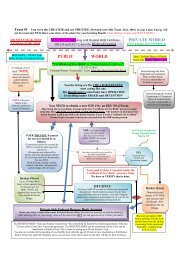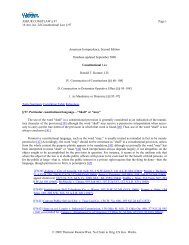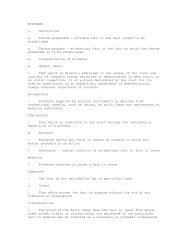The Healthview Newsletter, Issue #27-29 - Freedom School
The Healthview Newsletter, Issue #27-29 - Freedom School
The Healthview Newsletter, Issue #27-29 - Freedom School
Create successful ePaper yourself
Turn your PDF publications into a flip-book with our unique Google optimized e-Paper software.
<strong>The</strong> real secret to understanding human health is<br />
to understand the ratIOs between individual minerals.<br />
HEALTHVIEW: What specific mineral ratio do you<br />
look at to determine the health of the thyroid gland?<br />
"Calcium slows down the thyroid and potassium<br />
speeds it up."<br />
ECK: I use the calcium (Ca) to potassium (K) ratio,<br />
which I have labelled the "thyroid ratio."<br />
I use this ratio because calcium and potassium are<br />
the two specific minerals which regulate the thyroid<br />
gland. Calcium slows down the thyroid gland and potassium<br />
speeds it up. In order for this gland to operate<br />
at its maximum capacity, there has to be just the right<br />
balance between these two minerals.<br />
Ifa person has too much calcium in his tissues lin<br />
proportion to potassium) he will have an underactive<br />
thyroid gland. If he has an excess ofpotassium in his<br />
tissues (in proportion to calcium) he will have an ov·<br />
eractive thyroid gland.<br />
This is why once you know the ratio of calcium to<br />
potassium in the body you know immediately if this<br />
Calcium {Cal<br />
Potassium (Kl<br />
How to Tell How Efficient Your<br />
Thyroid Gland Is<br />
Underactive (Slow)<br />
40 or above 85'!! or more<br />
20·40 75·85% energy<br />
loss<br />
15·20 50·75% energy<br />
loss<br />
10-15 30-50% energy<br />
loss<br />
6-10 20-30"'" energy<br />
loss<br />
4.7-6 10·20% energy<br />
loss<br />
Energy Levels<br />
Very poor energy<br />
levels<br />
Poor energy levels<br />
Low energy levels<br />
Less than adequate<br />
energy levels<br />
Adequate energy<br />
levels<br />
Good to adequate<br />
energy levels<br />
If you have a hair test taken, you can tell immediately<br />
how healthy your thyroid gland is. All you have to do<br />
is to find your calcium (Ca) to potassium IKl ratio and<br />
then look on this chart. <strong>The</strong> closer your ratio is to 4.0<br />
the mOre energy you will have.<br />
If your reading says you have a IOCA energy loss,<br />
this ill still a large loss ofenergy. Even a 1O'h: energy los.<br />
will greatly affect your energy. Ifyour reading says you<br />
are Hfast" beyond a certain point, tbis too is not healthy.<br />
16<br />
gland is too fast or too slow, And not only that, but you<br />
know exactly how fast or slow it is.<br />
HEALTHVIEW: What is the normal value of the calcium<br />
to potassium ratio?<br />
ECK: It would be 4, You get that by looking at the<br />
normal values for calciumand potassium, which appear<br />
on Chart No. 1. Calcium is 40 and potassium is 10, so<br />
40 divided by 10 is 4.<br />
If a person had a ratio of4 to 1 between these two<br />
minerals, the thyroid gland would be functioning at<br />
peak capacity. This is, of course, assuming that the<br />
levels for these two minerals were also near normal.<br />
Now, by comparing a person's actual ratio with this<br />
normal ratio, you can tell if the thyroid gland is underactive<br />
or overactive. And Once you know this, you<br />
[Editor's Note: A scale of various thyroid and adrenaJ<br />
gland ranos appears 00 page 15 and 17, If<br />
you have aJready had a hair aoaJysis, you should<br />
get out your chart and check your own ranos and<br />
levels as we are discussing them. This will make<br />
this interview a thousand times more interesting.<br />
ICyou have not yet had a hair test taken, you should<br />
re-read this interview after you get yourhair anaJ·<br />
ysis back.]<br />
NORMAL<br />
*4.0 Normal Maximum energy<br />
levels<br />
Overactive (Fast)<br />
3.8·3.0 10·20% Good to adequate<br />
overstressed energy levels<br />
3,0·2.5 20-30% Adequate energy<br />
overstressed levels<br />
2.5·2.0 30-50% Less than adequate<br />
overstressed energy levels<br />
2,0·1.5 50·75% Low energy levels<br />
overstressed<br />
1.5·1.1 75·85% Poor energy levels<br />
overstressed<br />
Less than 1.1 85% or more Very poor energy<br />
overstressed levels<br />
A fast gland is a gland that will eventually wear out<br />
completely because of too much stress.<br />
lt i. extremely important to remember that to have<br />
maximum amounts of energy, your mineral ratio and<br />
your minerallevelsmust be normal. Ifyou have a perfect<br />
ratio with poor mineral levels (too high or too Jaw), it<br />
means your thyroid gland is weaker than the chart indicates.<br />
<strong>Healthview</strong> Newsletetr, <strong>Issue</strong> <strong>#27</strong>-<strong>29</strong>



